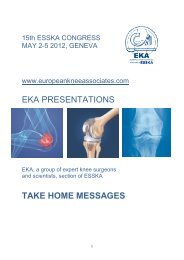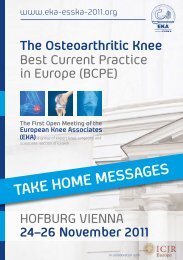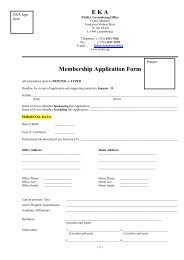Download the Take Home Message Book in PDF format
Download the Take Home Message Book in PDF format
Download the Take Home Message Book in PDF format
Create successful ePaper yourself
Turn your PDF publications into a flip-book with our unique Google optimized e-Paper software.
PATELLAR TRACKING<br />
Tibio-femoral dynamics<br />
Patellar motion is highly dependent upon tibio-femoral motion and may be highly abnormal even before<br />
TKA is attempted. Chronic ret<strong>in</strong>acular contracture can lead to poor patellar track<strong>in</strong>g, restricted flexion, pa<strong>in</strong><br />
and wear.<br />
Iatrogenic factors<br />
There has been an extensive and well-documented history of failure to adequately address patellar track<strong>in</strong>g.<br />
Even <strong>in</strong> recent analyses, over 15 percent of patellae have been shown to track abnormally. Iatrogenic<br />
factors <strong>in</strong>clud<strong>in</strong>g mal-position<strong>in</strong>g of components have been important <strong>in</strong> <strong>the</strong> past, but recent improvements<br />
<strong>in</strong> <strong>the</strong> understand<strong>in</strong>g of trochlear shape and position<strong>in</strong>g have helped greatly. Too thick a patella, oblique<br />
patellar cuts and mal-positioned buttons can lead to pa<strong>in</strong> and imp<strong>in</strong>gements. Overstuff<strong>in</strong>g of <strong>the</strong> extensor<br />
compartment can arise from anterior femoral position<strong>in</strong>g and oversiz<strong>in</strong>g.<br />
Deformity and contracture<br />
However, even when tibio-femoral jo<strong>in</strong>t dynamics have been optimised <strong>the</strong>re rema<strong>in</strong>s a cohort of patients<br />
of about 6% <strong>in</strong> an average knee arthroplasty practice, who will require some degree of soft tissue balanc<strong>in</strong>g<br />
of <strong>the</strong> extensor mechanism. This is particularly so <strong>in</strong> cases where <strong>the</strong> primary abnormality has been with<strong>in</strong><br />
<strong>the</strong> extensor mechanism and has led on to contracture of <strong>the</strong> lateral ret<strong>in</strong>acular structures and collapse of<br />
lateral patellar or lateral femoral bone.<br />
Assessment of track<strong>in</strong>g and its correction<br />
Intra-operative test<strong>in</strong>g should always <strong>in</strong>clude temporary partial closure of <strong>the</strong> medial parapatellar <strong>in</strong>cision<br />
and stress test<strong>in</strong>g of <strong>the</strong> whole knee construct while carefully observ<strong>in</strong>g patellar track<strong>in</strong>g <strong>in</strong>clud<strong>in</strong>g with <strong>the</strong><br />
tibia externally rotated. Staged lateral release can be performed us<strong>in</strong>g various techniques such as ‘piecrust<strong>in</strong>g’<br />
and ‘<strong>in</strong>side-to-out’ cuts. It is <strong>the</strong> authors preference however to use a staged , ‘proximal-to-distal’,<br />
‘outside-to-<strong>in</strong>’ method <strong>in</strong> order to m<strong>in</strong>imise risk of damage to <strong>the</strong> geniculate vessels and keep <strong>the</strong> knee<br />
cavity sealed from <strong>the</strong> subcutaneous plane. Once aga<strong>in</strong>, surgical navigation can assist with quantification of<br />
<strong>the</strong> severity of <strong>the</strong> problem and <strong>the</strong> efficacy of correction. Medial plication may be required, but must not<br />
be used <strong>in</strong> isolation aga<strong>in</strong>st tight lateral structures.<br />
Summary<br />
• Be aware of morphological variation <strong>in</strong> <strong>the</strong> knee and severe deformities<br />
• Optimise all component positions<br />
• Test and adjust tibio-femoral dynamics<br />
• Then test patella track<strong>in</strong>g<br />
• As a last resort, re-balance <strong>the</strong> soft tissues of <strong>the</strong> PFJ.<br />
35





